Use RF 100MHz to measure soil moisture IC generator plus IC detector
The main propouse of this emitter/receptor is to measure humidity in media sand.
Based on soil Volumetric water content sensor by vegetronix vh400 they use 80MHz signal and probe is only two pcb wires aprox 10cm long 2mm wide and 1mm spaced.
Maybe one wire is connected to some 80MHz generator and other pcb wire act as an antenna to a detector.
Is possible to do use this methood at 100Mhz using LTC6905 connected to one pcb wire and other pcb wire connected to RF detector?
High frequencies are aftected by surround moisture, so LTC5507 power detector can detect that variation.
RF theory is used for this vegetronix vh400, dont know what kind of thecnic they use but I'm thinking to use a LTC6905 plus a LTC5507 to measure reflected signal intensity.
Any help is welcome
Hi, there is some Vegetronix VH400 volumetric water content sensor using 80MHz to measure surround soil water content.
The probes are only two pcb strips with aprox 10cm long and 2mm wide spaced by 1mm.
What kind of method is used to do this measure?
One oscillator at 80MHz connected to one wire probe and other pcb wire connected to a detector?
Or is it using RC constant time and two pcb wires acts as capacitor, but injecting 80Mhz in circuit?
Any ideias are welcome.
" One oscillator at 80MHz connected to one wire probe and other pcb wire connected to a detector? " I do not think so, because both the receiver and the transmitter require some sort of earth. This could be by standing the instrument on the ground or by holding it.
One possibility is that one probe is "earth", the other is live and is fed with say 1V of RF, this probe is also connected to the RF voltmeter, so as the impedance falls between the probes the RF level falls and the output from the voltmeter goes down.
The other possibility is that both the RF and the metering section use push pull so the probes are driven with anti phase RF and the detector measures the anti phase RF. This will not be so sensitive to local earth resistance variations of the soil.
Frank
Hi, my ideia is this one.
I would not use linear technology linear power detectors I would use analog devices log power detectors. You will get another 30 dB of dynamic range, and the small levels will still be detectable due to the log detector transfer curve. use something like the AD8307
Thanks for help. Do you think using ltc6905 injecting 100MHz and using above schematic with AD8307 power detector is functional circuit?
How can I do impedance matching? the vegetronix uses two pcb wire strips 2mm tick spaced by 1mm.
What kind of impedance does it generate? Or how to calculate? Need to calculate also R to this circuit. And LC filter on power detector or maybe not..
Regards
Is this trustable source? How to know C1 = C2 = CC
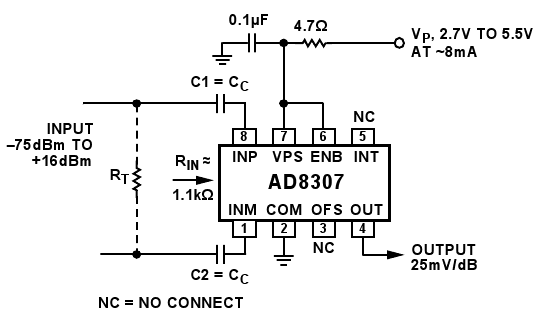
Hi, 100MHz-170MHz is better to have rectangle loop inductance or coplanar pcb strips?
Can someone choose best inductance for 100-170MhZ operation
www.eeweb.com/toolbox/rectangle-loop-inductance/
This is used in vegetronix VH400
http://www.eeweb.com/toolbox/broadsi...ce-inductance/
In case this is of interest, this simulation illustrates LC values which are compatible with 100 MHz through various ohm values. The bandwidth can be made wider or narrower by trying different L:C ratios.
Notice that different levels of signal get through as resistance changes.

I cannot say whether this is the optimum configuration of LC for your project.
Hi, thanks LC networks helps to get closer to real circuit.
According to oscillator data sheet it drives 500ohm load at 3V rail to rail output. Square wave.
How to know impedance at 80Mhz to 170MHz from two pcb strips 100mm long 2mm tickness and 1mm spacing center?
This calculated impedance from pcb strip's plus R should be equal to 500ohm to match oscillator output correct?
From above schematic AD8307 Power detector has impedance of 1,1Kohm input.
Any help to solve oscillator ic - pcb strips - AD8307 match is welcome or any possible LC network simulation at www.circuitlab.com for better understanding this case.
Vitoa that idea would work well if the line between the transmit and the probe was about half a wave length ( @80 MHZ ~ 2m). This would have the effect of transforming the far end impedance in a reciprocal way (Zfar end= O/C, shows S/C at near end and vice versa).
Waving a finger in the air, Xc 20pf = 10^12/ 2 X PI X 80 X 10^6 X 20 = 10^6/ 10,000 = 100 ohms. So to resonate out this 100 ohms of capacitance, we need 100 ohms of inductance. L = 100/2 X PI X 80 microH ~ .2 micro H, 200nH.
Frank
My tips:
* It is a good idea to send AC rather than DC through the probes. You may get by with a slower frequency than 100 MHz.
* Although many oscillators contain an inductor, you may find a plain RC oscillator is satisfactory. (One type is called a relaxation oscillator.) By attaching a series capacitor to a 555 timer IC output, you automatically turn it into a true +/- AC waveform.
* By sending current through water, you cause electrolysis, and dry out the soil. Instead you want to preserve the water if possible. Therefore apply tiny current to the soil, and as seldom as possible.
* Your sense resistor needs to have the right value, so that it produces a usable volt reading, based on current going through it.
* There may be an alternate to the sense resistor, if you were to measure the soil resistance as a parameter of your oscillator, such as its frequency, or some feedback effect, etc.
* Did you use a meter to get measurements of soil resistance, both dry and moist? This gives you real life information, to help you determine the best topology for your project.
The transmission line need to be multiple of wavelength.2m is for dipole This sensor acts as a antenna, but almost no gain.
I found web site to calculate coplanar capacitor.
http://www.daycounter.com/Calculator...lculator.phtml
Equation:
C= K*Eo*A/D, where Eo= 8.854x10-12
where:
K is the dielectric constant of the material,
A is the overlapping surface area of the plates,
d is the distance between the plates, and
C is capacitance
A (plate area) 20 (mm2)
d (distance) 0.1 (mm)
K(dielectric constant inside 4layer pcb) 4.2
Capacitance 7.44 (pF)
distance 0.05mm capacitance = 14.9pF
The closer the strips the long the range of electromagnectic field.
I also calculated the capacitive reactance impedance of this strips 10mm*2mm = 20mm2
http://www.sengpielaudio.com/calculator-RC.htm
For example 10pF at 100MHz has an resistance of 159ohm.
This two strips on pcb are used on vh400 sensor at 80MHz . Kind of 80MHz antenna with receiver do DC.
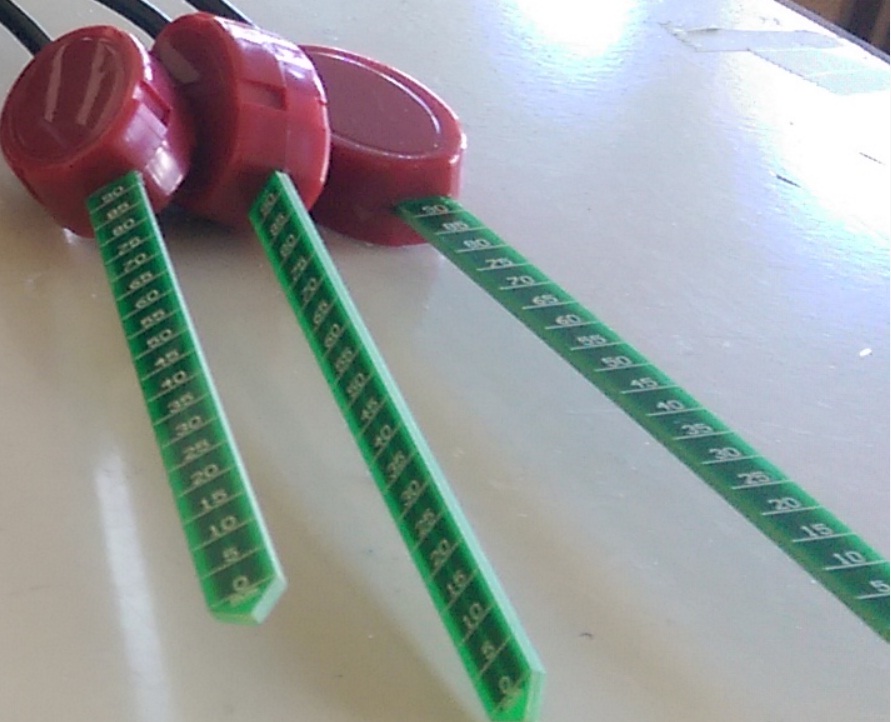

The two strips have 10pF equals to ~160ohm at 100MHz and AD8307 power detector has internal resistence 1,1Kohm.
Oscillator output cmos can drive 500 ohm at 100MHz 3V rail to rail output.
The AD8307 has an resistence of 1,1Kohm
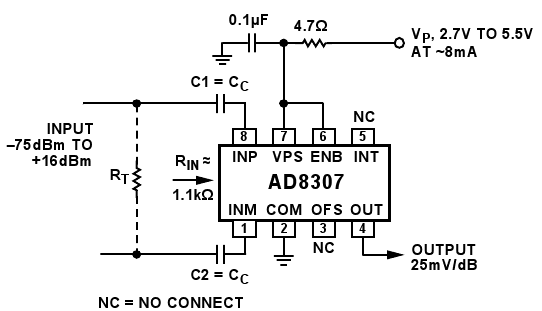
probe capacitance.
A (plate area) 20 (mm2)
d (distance) 0.1 (mm)
K(dielectric constant inside 4layer pcb) 4.2
Capacitance 7.44 (pF)
picture: electromagnetic field

How can I configure external R , C or L needed?
This circuit is a power meter with AD8307
How can I redesign this RLC network to mach two pcb strips at 100MHz?

LC ressonance calculator
http://www.daycounter.com/Calculator...lculator.phtml
If frequence 100MHz and capacitance from probe 10pF inductance will be 253nH
It is becoming more clear what is the concept of measurement. Evidently it is not plain resistance. (Therefore my tips in post #10 are irrelevant.) Instead it appears that an rf field is sent out into the surrounding soil. A high frequency is suitable.
The capacitive strips have to do with creating an electric field rather than an rf magnetic field. We wonder which type of field is vital to taking measurements? So perhaps you need a component that creates an rf magnetic field. (I'm not an expert so I could be wrong.) Perhaps you need both L & C components.
RF behavior is affected in some way by water content. Perhaps it inhibits rf from being radiated, or accentuates it, or tries to change the frequency of rf. The IC may be able to interpret results. The question is, What degree of 'smarts' is in the IC? How many additional components does it need to yield usable readings? Does it resemble your schematic in post #4?
It will require someone with more knowledge than I have, to give a ready answer.
I think one has to be careful of shunt capacitance which will cause a RF current from either or both of the probes flowing into the general soil. That circuit with the current sense resistor will be prone to this sort of error, but if a resistor is used in each line and balanced Coax is used then the voltage drop from resistor to resistor can be used as its truly differential and will ignore the common mode RF flowing to earth.
Frank
Realistically if I wanted a single frequency 100 MHz signal, I would use a 100 MHz crystal or saw oscillator, and a buffer amp between it and the antenna.
If I wanted a tunable source I would use a PLL with integrated VCO, like analog devices ADF4360-8, again followed by a buffer amp for isolation from the soil load.
Because there will be a lot of path loss between the TX and RX antennas, it is nice to have the transmitter electronics in one shielded metal box, and the RX electronics in a 2nd shielded RX box. you would need two chips to do that
I've done some real measures with some pcb soil probes prototypes. I'm measuring real capacity of probes with added surrounding soil.
Check picture or download all measures.
Zip files with all pictures:
https://db.tt/8sYxqNIM
We can see some difference every probe measure real situation.
The capacimeter test frequency is low. Low frequency means less range probe, but still measure the changes from surrounding dielectric.
The ADF4360-8 is advance synthesizer and needs microcontroller connection. Is great because can go much high frequency but more complex. LTC6905 needs few extra components and can go up 170MHz 2,7V -5,5V supply (using with 3,7V lipo cell)
ADF4360 suits perfect for a higher frequency probe.
This LTC6905 is going to inject 100MHz 3V rail to rail into sensor probes. But circuit need to match detector AD8307 with miniminal external components. AD8307 have a 30dB range so 25mV/dB equals to 0,75V interval output DC logaritmic.
I'm thinking going to a wheatstone bridge instead of AD8307 detector.
Lowest cost and precise mesure. LTC6905 will be inject 100MHz at weatstone bridge, and know variable capacitor probe to DC out.
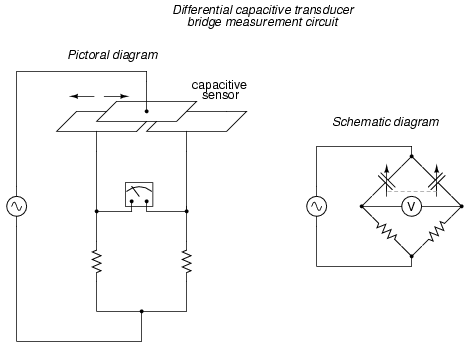
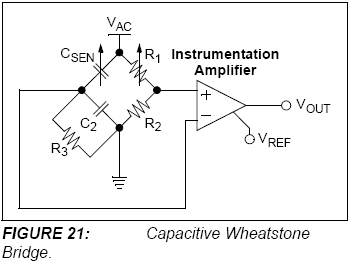
Probe range is from 10pF to 500pF. How do I calculate the RC network?
Need also single supply low power amp op. Any sugestion?how many bandwidth needed? Is OPA170 ok for a 100MHz wheatsone bridge?
I guess I am confused. You only want to measure capacitance? Why not use a capacitance measuring chip, like the Analog Devices AD7745? they have an eval board too.
My Plant Watering Watcher project uses 4kHz to measure the conductivity of soil and it clearly shows dry or damp soil. Soil usually has fertilizer salts that conduct when damp. My tap water conducts a lot and distilled water does not conduct.
My project feeds AC, not DC to the probes. It uses PWM to adjust the brightness of an LED that flashes to conserve battery power. When the soil is damp the LED does not light and when dry it is fairly bright.
Two AAA alkaline cells power my project for months or years until the battery voltage drops to below 2V.
AD7745 measures capacitances but not with a 100MHz source. Maybe only 32KHz.
Plant Watering Watcher is a great circuit.4khz does not have full transparency to minerals. Conductive technic corrodes probes with time. Any way your circuit is nice and maybe I would need it.
Oscillating at 100MHz means measure of soil water content only, fully transparency to water minerals. tap water arroud 400ppm. But some water with fertilizeres can go up 3000ppm. Soil with fertilizer can increse very much ppm.
Sensor at low frequency measures water plus minerrals. Minerals need to be excluded from measure. 100MHz oscillator needed.
Each soil has its own mineral ppm so low freq sensor will change values soil to soil. Not precise.
Your sensor measures resistence, so to measure capacitance need ac source and LC at ressonance to view it as pure resistence.
I'm going to a new concept please check https://www.edaboard.com/thread353606.html
But any new comments here are welcome or any discuss about developing an open source low cost soil moisture sensor. Many educative info is here on posts for those who want to know better how soil moisture works. Happy learning.
Regards
